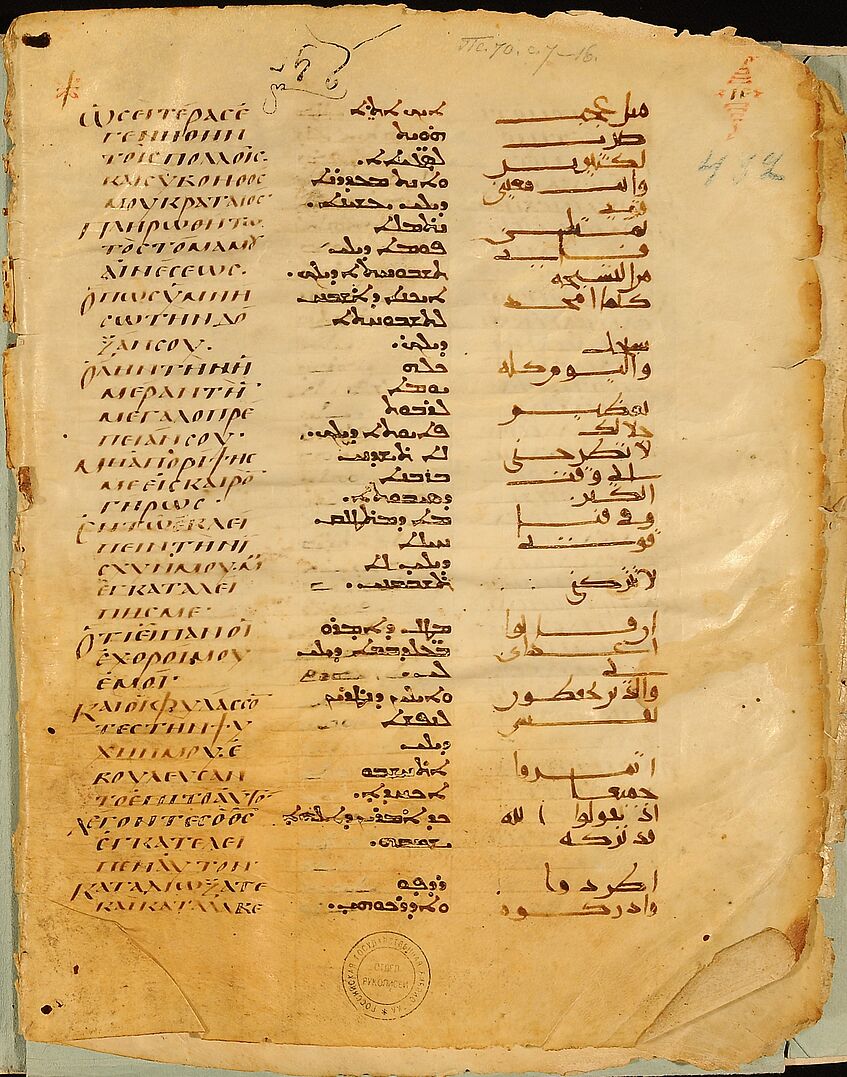The Making of the Byzantine Ascetical Canon: Monastic Networks, Literacy and Religious Authority in Palestine and Sinai (7th-11th centuries) (MonasByz)

A ninth-century trilingual Greek-Syriac-Arabic Psalter from the area of Jerusalem (Moscow, RGB Φ. 201 No. 18-1) (c) Russian State Library
The Making of the Byzantine Ascetical Canon: Monastic Networks, Literacy and Religious Authority in Palestine and Sinai (7th-11th centuries) (MonasByz)
Project Title: The Making of the Byzantine Ascetical Canon: Monastic Networks, Literacy and Religious Authority in Palestine and Sinai (7th-11th centuries) (MonasByz)
Funding: Marie-Skłodowska-Curie Individual Fellowship (MSCA-IF)
Funding Period: 2020-2022
Postdoctoral Researcher: Dr. Adrian C. Pirtea
Host: Prof. Dr. Claudia Rapp
Project Summary:
Palestine and Sinai played a key role in the development of the monastic and ascetic tradition in Eastern Christianity in late antiquity and the Middle Ages. After a demographic and cultural peak during the early Byzantine period (fifth-sixth century), Palestinian monasticism was deeply affected by the seventh-century Islamic conquests, which brought about radical changes in the region. Nevertheless, monastic life and literature continued to flourish in the new political context of the early caliphate. Together with the on-going literary activity in Greek, this period witnessed the emergence of a Melkite Syriac, Christian Arabic and Georgian literature. Monasteries such as St Catherine’s on Sinai or Mar Saba near Jerusalem became important cultural centers fostering multilingual monastic communities.
The aim of this research project was to investigate the role played by these communities in the formation of the Byzantine literary canon of ascetic works. Throughout the medieval period, monastic audiences across the Mediterranean relied on the late antique ascetic writings of the fourth-seventh centuries CE as their main source of religious authority. Although the reception of these ‘classics’ had far-reaching consequences for the religious and intellectual history of the Mediterranean, key questions regarding the processes of transmission, reception, and adaptation of these texts are still open: How did a canon of ascetic literature emerge, who carried out the selection of authors and works, and how were these selections disseminated? Based on a detailed study of the ascetic manuscripts from Palestine and Sinai, the project argues that the large monastic centers in these regions played a pivotal role in this development.
The first objective of the project was to identify and analyze the Greek, Syriac, and Arabic ascetic manuscripts copied in the region between the 7th and 10th centuries. The second objective was to study the most important features and textual practices in these ascetic collections (translation techniques, selection criteria, etc.). Moreover, the identification of the scribes and users of these manuscripts allowed for a reconstruction of the institutional and personal networks that worked as channels for transmitting ascetic knowledge in the Eastern Mediterranean during the early Islamic period. Based on these insights, the final objective of the project was to explain how a canon of monastic and ascetic literature, mainly consisting of late antique authors, was formed in the middle and later Byzantine period, and to assess the role played by the Palestinian monastic centers in this process. The results of the project have been disseminated at thirteen international conferences and lecture series. The Researcher has also organized a workshop at the University of Vienna on 7-8 April 2022 (online), with the participation of twelve leading scholars in the field. The workshop attracted over 180 registered participants and its proceedings will be published as a special issue in a peer-reviewed academic journal (with a total of seven contributions). Another five scientific articles and book chapters, illustrating the main results of the project, have either been published or have been submitted for publication.
The systematic study of the ascetic manuscripts from Sinai and other collections and libraries has also brought to light a series of hitherto unidentified or unknown ascetic texts in Syriac and Arabic. These identifications contribute to a better understanding of the intellectual activities in the monastic centers of Palestine and Sinai, but also illustrate the channels through which late antique ascetic authors were transmitted and read in later periods. Other significant advances were made regarding the complex textual history of the Apophthegmata Patrum (“sayings of the Desert Fathers”). The ‘canonical’ form of these anthologies in Greek have replaced several older, non-standard collections, which have only survived in early Syriac and Arabic translations. Palestinian and Sinaitic monks thus played a central role in the transmission, selection, but also censorship of these ascetic collections. Research on these collections and texts now continues within the framework of the ERC Starting Grant “RevIdEM” led by Adrian C. Pirtea at the Austrian Academy of Sciences (2023-2028).
